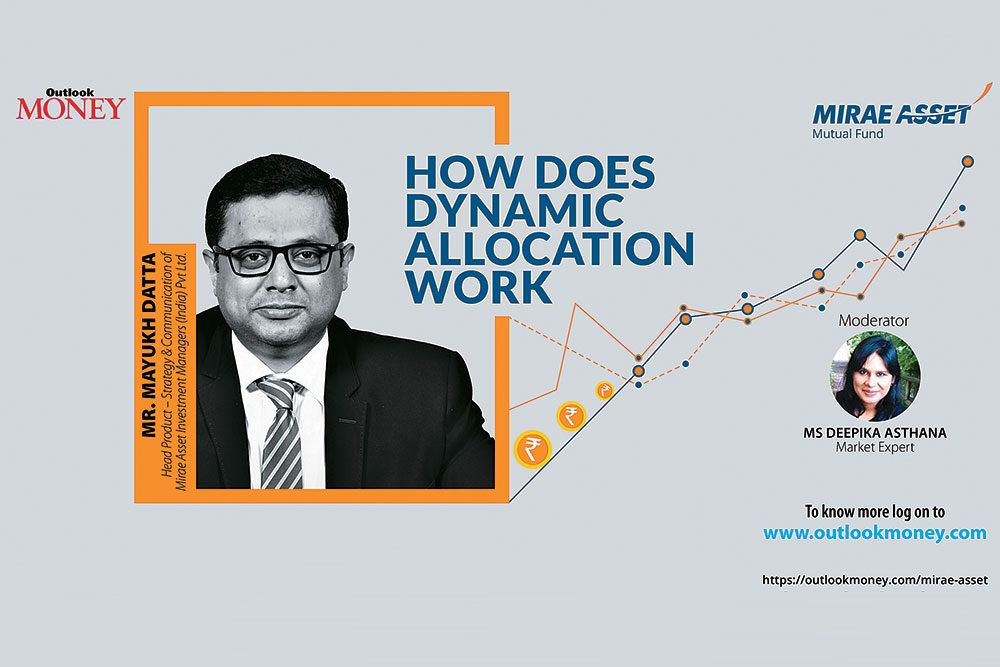Balance advantage funds and dynamic asset allocation are the buzzwords amid the ongoing volatility with investors worried about questions such as how much to invest in the market, how long to invest and when to withdraw.
A recent discussion with Mayukh Dutta, head, product, strategy and communication, at Mirae Asset Mutual Fund on ‘Balanced Advantage Funds/Dynamic Asset Allocation Funds’ threw some light on it. Dutta was in conversation with Deepika Asthana, market expert.
Here are some edited excerpts from the discussion.
How Do They Work?
Within equity mutual funds, there are some categories that invest in different kinds of companies. Similarly, balanced advantage funds invest in different kinds of assets.
“Balance advantage funds or dynamic asset allocation funds are the same when it comes to the name of the schemes. Their objective is the same. They invest across asset classes. Like you have flexi-cap equity funds, think of these as a flexi-asset product which can invest into different asset classes at any point of time. Yes, it would have certain limitations in terms of where it can invest, how much it can invest, but overall it can invest across asset allocations,” says Dutta.
How Do They Help Investors?
When the markets are volatile or are moving in a certain band, the fund manager is able to take the call of moving out of debt or moving into equity or into arbitrage or something else that is allowed to be dynamically managed, says Dutta.
“How it helps the investor is that they are able to get a certain amount of participation on the equity side, but during volatile times if the fund managers were taking some strategies and reducing their equity positions, they are also getting an experience of lesser volatility. Sometimes investors would like to do it themselves, but these funds are also able to do it. And if you like that strategy, you can invest,” he says.
They can also help fight behavioural biases. Greed and fear go hand in hand with market movements and these funds can help counter that. “A fund, when it is following certain rules or some investment objectives, is able to do it because it is doing it as a fund and it is doing it for everybody. The fund is behaving in that manner which is by buying low and selling high. This can be done individually but that’s easier said than done,” says Dutta.
Then there are costs attached to switching yourself which these funds do not eantail. “First, your timing and call has to be right, you have to go through a process of exiting and then probably buying. Second, there is a tax angle to it. Third is the question whether or not you will actually be able to do it. Dynamic asset allocation funds can do all this on the investors’ behalf.
How To Choose A Fund?
To be able to delve into each scheme model, understand the metrics and then see which metrics suit them better is slightly difficult for investors.
Talking about the solution to this, he adds, “A way to compare funds or to find which one is better is to go back to the basics, which is to see what the fund offers, which model it uses and whether that is in line with the investor’s objective.”
Look at the fund’s ability to limit the downside. Similarly, see how the fund performed and behaved when markets were moving up or down. Was it able to participate in the upside and shield you from the downside? Just looking at point-to-point returns is not enough, one must also look at whether the fund is true to its mandate and the model it follows, says Dutta.
Is Asset Allocation Enough?
“Asset allocation is a subdivision of your investment goals, which could be a month away or one year away or may be due in 10 years. Each objective would need a different approach and asset allocation. To say that one asset allocation fund will be able to overarch all the requirements which are probably for next week till up to 30 years may not be possible,” says Dutta.
Dynamic asset allocation and balanced advantage funds basically provide a middle path and can help some of the goals but not all. But it will definitely help you participate in different market cycles.
Disclaimer
An Investor Education & Awareness Initiative by Mirae Asset Mutual Fund.
For information on one-time KYC (Know Your Customer) process, Registered Mutual Funds and procedure to lodge a complaint, refer to the knowledge center section available on the website of Mirae Asset Mutual Fund
Mutual Fund investments are subject to market risks, read all scheme related documents carefully.

